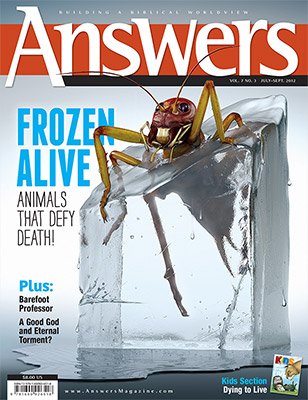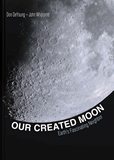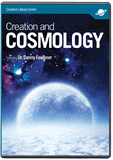Latest Lunar Hypothesis on the Rocks
The rocks that Apollo astronauts brought back from the moon helped to demolish pet evolutionary ideas about the moon’s origin. So scientists came up with a new hybrid. A fresh look at the moon rocks has threatened this new idea, too.
It’s a thrilling tale! Billions of years ago a young planet, called Earth, was in the early stages of becoming habitable when tragedy struck. A rogue planet named Theia, roughly the size of Mars, careened into Earth, sending debris everywhere. The Earth absorbed the planet’s core and most of its material. But some of the debris accumulated into our moon, which displays a freakish combination of traits from both its parents.
For more than thirty years, that is how most evolutionary scientists have explained the moon’s origin. How else can we explain the moon’s unique combination of traits, unlike anything else in the solar system? Until recently, the giant impact hypothesis satisfied many of their questions.
A new study has thrown this hypothesis into the air.1 If two planets formed the moon, we would expect it to have a unique mixture of materials, different from those on Earth. To test this, scientists took another look at the lunar rocks brought back by the Apollo astronauts. They focused on the element titanium.
On Earth, titanium comes in predictable combinations. While every atom of titanium contains 22 protons, the number of neutrons can vary from 24 to 28. These variations are called isotopes. For instance, the isotope titanium-48 consists of 22 protons and 26 neutrons. It is the most common isotope of titanium on Earth.
The new research studied the ratio of two isotopes—titanium-47 and titanium-50—found in twelve lunar rocks. The ratio was similar from rock to rock, indicating that this is a common ratio on the moon. More surprising, this is the same ratio found in rocks on Earth. This finding causes problems for the “giant impact” hypothesis. The moon ought to be a mixture of matter from both Earth and Theia. We know from studying meteorites that extraterrestrial bodies have different isotopic ratios, so how could the moon match the Earth?
This is not a new problem. Scientists have long known that the three isotopes of oxygen—oxygen-16, oxygen-17, and oxygen-18—have the same ratio on the Earth as they do on the moon. This similarity was explained by assuming that the oxygen mixed together right after the collision, leaving behind the same ratio on Earth as in the debris that formed the moon. But this explanation won’t work for titanium. Titanium has a very high boiling point compared to oxygen. So the rocks from Theia could not have gotten hot enough to melt and mix so thoroughly with rocks from Earth.
The new study, if confirmed, may force scientists to return to the drawing board for a new theory.
This new study, if confirmed, may force scientists to return to the drawing board for a new theory of the moon’s origin. This is not the first time scientists have revised their hypotheses. Fifty years ago three other theories competed to explain the moon’s origin. Indeed, settling this dispute was a major reason for the Apollo program. One theory claimed that the Earth formed first but it rotated so rapidly that it spun off material that coalesced into the moon. A second theory said the Earth and moon formed simultaneously from the same clump of matter. The third theory held that the moon formed elsewhere and then was captured as it passed by Earth’s gravity.
Most scientists liked the second theory—that the Earth and moon formed simultaneously—because the other two challenged the fundamental laws of physics. However, the types of elements in the lunar rocks brought back by the Apollo astronauts appeared to rule out all three theories. In the post-Apollo world, scientists developed the giant impact hypothesis as a sort of hybrid of the three older models.
How do creationists view the moon’s origin? The Bible reveals that God made the lesser light (the moon) on Day Four and ordained it to fulfill several purposes (Genesis 1:14–19). Since each day of Creation Week was a normal day, the moon could not have formed through some gradual process, but rather was made very rapidly. In light of special creation, it isn’t surprising that lunar characteristics defy any gradual, evolutionary explanations.
In fact, we might expect the moon to have unique characteristics unlike any other object in the solar system. For instance, most moons orbit their planet’s equator, but not the Earth’s moon. Our moon is the only one that orbits close to the ecliptic—the plane of the planet’s orbit around the sun. This orbit, along with the moon’s uniquely high mass relative to the earth, stabilizes the Earth’s rotation axis at 23.5 degrees. Without this stabilizing influence, the Earth would wobble erratically, wreaking havoc on our seasons. Instead, we have regular seasons by God’s wise design.
Our moon’s purposes are different from other moons: for the benefit and blessing of mankind, as we worship and serve our Creator on Earth.
Answers Magazine
July – September 2012
It’s impossible to explain how even one creature could evolve by chance, but in fact all life needs a complete community of other organisms to survive. The web of life had to be in place from the very start for any of us to exist. What an amazing testimony to the Creator! Also learn about animals that seem to come back from the dead, robotics, and how archaeology in Jordan confirms the Bible’s history.
Browse Issue SubscribeFootnotes
- Junjun Zhang et al., “The Proto-Earth as a Significant Source of Lunar Material,” Nature Geoscience 5 (4): 251–255.
Recommended Resources

Answers in Genesis is an apologetics ministry, dedicated to helping Christians defend their faith and proclaim the good news of Jesus Christ.
- Customer Service 800.778.3390
- © 2024 Answers in Genesis









